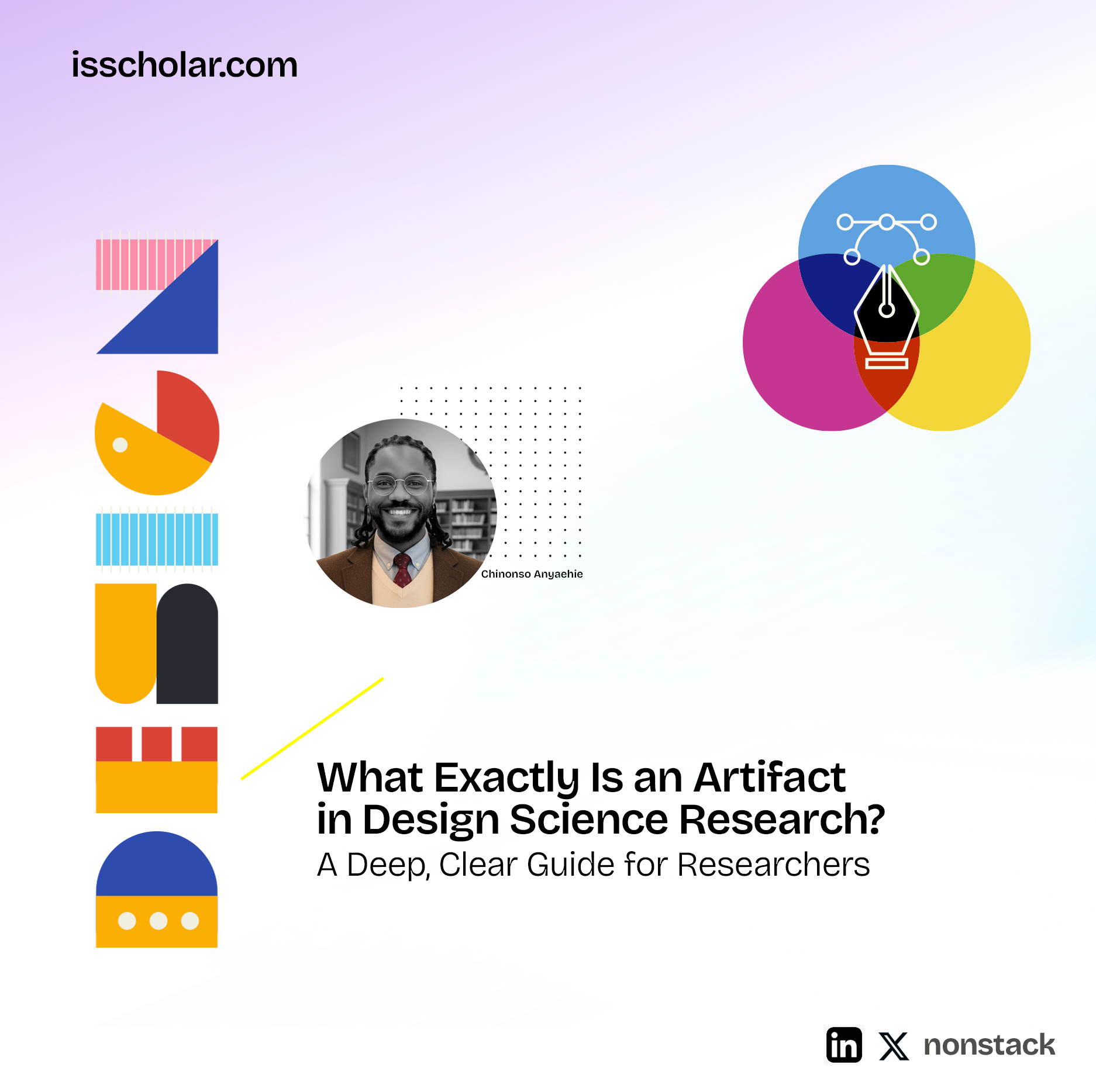Design Science Research (DSR) is becoming one of the most influential approaches in Information Systems, yet many researchers still struggle with one of its most fundamental concepts: the artifact.
What is an artifact?
How does it relate to knowledge?
And why isn’t building something enough for a publishable DSR paper?
This article gives a complete, accessible explanation of what the artifact is, why it matters, and how it contributes to knowledge in DSR.
1. The Artifact Is Central But Often Misunderstood
In DSR, everything revolves around the artifact. It is the centerpiece of the research, the mechanism through which new knowledge is discovered, and the tangible embodiment of innovation.
But one common misunderstanding persists:
Many people assume the artifact itself is the research contribution.
This is only partly true.
Yes, you need to build something.
But the real contribution lies in the knowledge that arises from creating and evaluating the artifact.
Think of the artifact as the laboratory experiment in natural science.
It is what enables new insights to emerge.
2. So What Counts as an Artifact?
An artifact is any purposeful creation designed to solve a problem.
It can be:
A physical or digital product
- A software system
- A mobile app
- A simulation tool
A process
- A workflow
- A method
- A step-by-step procedure
A conceptual creation
- A model
- A framework
- An algorithm
- A decision logic
The key idea is this:
If you can build it, describe it, test it, or use it to address a real problem, it can be an artifact.
Many artifacts are abstract in their early stages—such as models, logic diagrams, or pseudocode—but can be turned into something tangible.
For instance:
- An algorithm becomes a running program.
- A conceptual model becomes a working system.
- A process becomes an implemented workflow.
DSR embraces this entire spectrum.
3. Why Theory and Artifact Should Not Be Confused
A theory is abstract knowledge, while an artifact is a purposeful creation.
A theory:
- Does not exist physically
- Explains relationships and mechanisms
- Helps predict or understand behavior
An artifact:
- Can be built, instantiated, or executed
- Solves a problem
- Generates evidence
Both are valuable, but they serve different roles.
In DSR, confusion arises when people try to collapse everything into “the artifact,” including design principles, constructs, and even theory. But these are different forms of knowledge that emerge from the artifact, not the artifact itself.
4. The Artifact Alone Is Not Enough for Publication
A working prototype, by itself, rarely qualifies as a complete DSR contribution.
Why?
Because a single instantiation:
- Only solves the problem for one context
- Does not generalize
- Does not abstract principles that others can apply
- Does not extend scientific knowledge
A useful example is the early work on association-rule mining in data analytics. The researchers built operational software to test their ideas on supermarket data. But the lasting contribution came from what they abstracted:
- New constructs like “support” and “confidence”
- Generalizable algorithmic steps
- A reusable method
- Rules that could be applied in many other contexts
These abstract components allowed the work to evolve into a foundational method in data mining. The prototype wasn’t the impact; the knowledge behind it was.
5. The Three Levels of Knowledge Contribution in DSR
A DSR study can contribute at multiple levels. Understanding these levels helps clarify what a strong DSR article needs to deliver.
Level 1: The Concrete Artifact (Instantiation)
This is the actual product or system you built.
Examples:
- A prototype
- A dashboard
- A decision-support tool
- A chatbot
- A machine learning pipeline
This level demonstrates feasibility but has limited generalizability.
Level 2: Abstracted Design Knowledge
This is the heart of most DSR contributions.
It includes:
- Design principles
- Constructs
- Models
- Methods
- Algorithms
- Technological rules
This knowledge explains:
- How the artifact works
- Why it works
- How others can adapt or reuse it
This is what makes the research valuable to other scholars and practitioners.
Level 3: Full Design Theory
This is the most mature form of design knowledge.
A design theory includes:
- Meta-requirements
- Meta-design
- Kernel (justificatory) theories
- Design rules
- Boundary conditions
- Explanations for why the design works
Developing a full design theory takes time and typically requires multiple research projects across several years.
Most single DSR papers contribute at Levels 1 and 2, with Level 3 emerging from cumulative work.
6. Why Mature DSR Knowledge Requires Abstraction
Knowledge becomes more valuable as it becomes:
- More general
- More abstract
- More reusable
- Better justified
- More clearly bounded
A prototype helps you discover knowledge.
The design principles and constructs you abstract from that prototype help you distribute knowledge.
And a design theory helps you consolidate knowledge.
This progression mirrors how scientific understanding matures in any discipline.
7. The Role of Kernel and Justificatory Knowledge
Design principles don’t stand alone. They rest on a foundation of supporting insights known as kernel theories or justificatory knowledge.
These can come from:
- Psychology
- Economics
- Human–computer interaction
- Sociology
- Computer science
- Practitioner expertise
- Field observations
Kernel theories explain why your design should work.
Justificatory knowledge includes everything you used to inform the artifact’s design—and everything you learned while building it.
Both strengthen the credibility and generalizability of the contribution.
8. The Big Picture: Why This Matters for DSR
Understanding the artifact properly helps researchers:
- Build stronger DSR papers
- Present clear contributions
- Avoid confusing prototypes with knowledge
- Make their work relevant beyond one use case
- Create more robust and reusable design knowledge
Design Science Research is not just about building things.
It is about building things that teach us something.
And that “something” — the knowledge — is what DSR contributes to science.
Final Takeaway
A DSR artifact is more than a prototype. It is the starting point for creating new knowledge. A strong DSR contribution includes:
- A purposeful artifact
- Abstract design knowledge derived from the artifact
- Justificatory and kernel theories that explain why it works
- Generalizable principles that others can apply
When these pieces come together, DSR becomes a powerful engine for innovation and scientific advancement.









Leave a Reply